Cynthia awoke in the middle of the night with the record pressing plant on her mind. Had she been dreaming about the building that had once stood near her home? Although she hadn’t thought about the ruined plant in years, she suddenly felt compelled to learn more about it. Cynthia slipped out of bed to grab her laptop and googled ‘record company Owosso Mi’. The results of her online search would lead to not only a surprise but also some amazing discoveries that would inspire a quest to uncover the long lost story of the American Record Pressing company.
Cynthia Mallery was born in Owosso in 1973. She grew up there and graduated from Owosso High. She moved away, and got married before moving back to Owosso in 2002. Cynthia had never heard the name ‘American Record Pressing’ until this writer came to her door seven years ago. I had driven to Owosso to try and locate a photo of the ARP building for a course I was teaching on the history of Motown for the Osher Lifelong Learning Institute at Saginaw Valley State University. Having no luck at the city’s public library, I motored out to the site of the former record pressing plant on W. King Street to take some photographs and possibly speak to some of the homeowners living near the site.  Vee-Jay Records was an important ARP customer - In 1964 ARP pressed a number of hit records by The Beatles on Vee-Jay and Tollie, its subsidiary label - These included # 3 "Please Please Me", # 2 "Do You Want to Know A Secret", # 2 "Twist And Shout", and # 1 "Love Me Do"
Vee-Jay Records was an important ARP customer - In 1964 ARP pressed a number of hit records by The Beatles on Vee-Jay and Tollie, its subsidiary label - These included # 3 "Please Please Me", # 2 "Do You Want to Know A Secret", # 2 "Twist And Shout", and # 1 "Love Me Do"
Although none of the homes built on the then-unpaved street had the same address as the American Record Pressing building, Cynthia’s home address was the closest. I knocked on the door and spoke with Cynthia and her husband, Matt. During our conversation, I told them that the American Record Pressing company was significant in that it pressed the very first Motown and Beatles’ 45 rpm records issued in the United States.
I learned that Matt and Cynthia bought the property on W. King Street two or three years after they were married. They were wed in Tennessee, moved to Lansing, had their daughter Hunter, and then bought the property in Owosso where they built their home. The couple had no knowledge of what had been on the land previously until they came out and watched the crew push the dirt around and found all of the broken pieces of vinyl records. They then asked the former owner of the property about it and he told them that it had once been the site of a record company.
Cynthia and Matt found several pieces of equipment including what might have been an original metal plate used in the pressing process in the plant but, unfortunately, threw out all of what they had discovered. They had been busy constructing their new home and raising their daughters; and said that they had “never thought twice” about the record company building that had burned down over thirty years ago even after they discovered that Cynthia’s grandmother, Joan Mallery, had once worked there.  The record presses at ARP in the 1960's
The record presses at ARP in the 1960's
Her grandmother’s job was to grab the handle of the press and press it down into the vinyl to produce the platters. The handle was very hot and Joan couldn’t use a glove or any protective cloth on her hands for fear that fibers might fall into the vinyl. Joan Mallery hated the job and told Cynthia that she didn’t work there very long. Cynthia’s father remembered it differently, however. ARP hired mostly women to run the presses and the work paid well. He told Cynthia that her grandmother worked at ARP longer than she claimed since he remembered her going to work at the plant while he was growing up.
Joan Mallery was no longer employed at ARP at the time of the fire in 1972. After leaving her job in the pressing plant, she went to work at Tanneyhill Bakery, a family-owned business that operated in Owosso for over 60 years. She then moved to the city of Corunna, located 12 miles east of Owosso, where she started her own business, Joan’s Donuts. Joan’s family worked there and it was also the site of Cynthia’s very first job. Years later, Cynthia followed in her grandmother’s footsteps and established her own business in her home, a salon where she does hair. 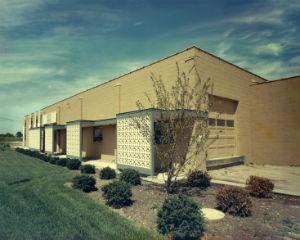 The ARP building in the 1960's
The ARP building in the 1960's
Her interest in learning more about ARP didn’t really start with my visit, however. Cynthia and Matt talked about it, but the urge to look it up and learn more was not immediate. Cynthia had never been into music and knew nothing about Motown and the older music that would have been ARP’s business from the early 1950’s when the plant moved to Owosso until the fire in 1972 that destroyed it. They kept my MRRL business card I had left in case they found more information about ARP taped to their refrigerator, but they had never visited the web site and eventually threw it away. Cynthia figured she would never learn anything more about the American Record Pressing plant, nor did she really care to at the time.
Things changed, however, on October 29, 2013. Cynthia went to bed and had fallen asleep for a short time when something woke her. She suddenly had an urge to look up the record company that had been located on her property. She got out of bed, grabbed her laptop and typed in “record company Owosso Mi”.
She clicked on the Michigan Rock and Roll Legends' story ARP - Owosso’s Connection To Motown And The Beatles. It contained a brief history of ARP which included pressing the first Beatles’ 45 issued in America, “Please Please Me”, and the fact that the band’s name was misspelled “Beattles” on the label. It also mentioned how Berry Gordy Jr. and Smokey Robinson drove to Owosso during a snowstorm in 1959 to pick up the very first 45s issued by Motown’s Tamla label, Marv Johnson’s “Come To Me”.
As Cynthia read further, she got to the devastating fire that put ARP out of business on October 30, 1972. Cynthia suddenly got chills. She looked at the clock. In 30 minutes it would be the 41st anniversary of the fire. For 11 years she had little interest in finding out information about ARP and then she suddenly awakens in the night and finds a story about it just minutes before the 41st anniversary of the fire? It seemed a strange coincidence. 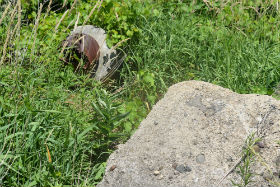 Remnants of the former ARP building
Remnants of the former ARP building
It got stranger still as she read how the writer of the story drove to the former ARP site and found new homes in its place. It went on to describe the attractive young couple who lived near the spot where the plant once stood and the grandmother who had once pressed records at ARP. Cynthia discovered that she was an important part of the story as it recounted how she and her husband invited him to go out into the field behind their house where there were thousands of pieces of broken vinyl records.
What made her decide to get up and look up that information about ARP on the anniversary of the fire after living on the site of eleven years? Whatever it was, it started Cynthia on a quest to find out as much as she could about the American Record Pressing company. 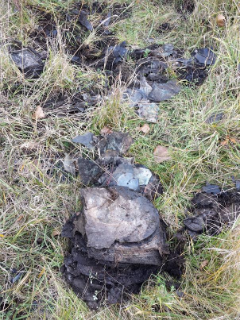 The site where Cynthia dug up the first group of albums
The site where Cynthia dug up the first group of albums
Two days later, Cynthia had two clients cancel their appointments at her hair salon. She suddenly decided that she would go outside and do some digging to see what she could find. She walked out into the huge field behind her house, quite overwhelmed and with no idea where to begin.
During an interview with me several weeks later, Cynthia recalled her experience: “It is so hard to describe how I felt out in the field that day. I was standing on top of the pile of remains from the ARP building," she said. "I guess I chose the pile to stand on because it allowed me to be taller than the grass and weeds so I could decide where to dig. I stood there, I'm guessing, 8 to 10 minutes. It was just a beautiful day, the last beautiful day before the cold weather hit; so I was soaking up the sun as I stood there looking around.”
“But all of a sudden I got an anxious feeling when I looked at this certain spot; and that feeling made me jump down from the rubble and go check it out," she recalled. "When I got to the area, there was a thorn bush on a small mound about 2 feet taller than the rest of the ground, and that mound beneath the bush is was attracted me as I stood there. So I dug my first shovel into the side of that small mound next to the bush and that is where I found an 8-inch stack of fully intact vinyl albums. I honestly couldn't believe my eyes! I was so excited! Even though I had no idea what I had found or whose records they were, it was so neat to pull from the ground history from 40 years ago! These were someone’s dreams that I held in my hands!” 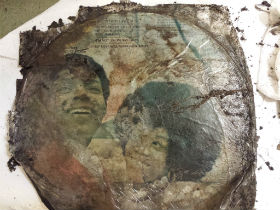 One of Cynthia's initial finds was the remains of a 1972 album by Chee Chee and Peppy, a singing duo that recorded for Buddah Records
One of Cynthia's initial finds was the remains of a 1972 album by Chee Chee and Peppy, a singing duo that recorded for Buddah Records
I first learned of Cynthia’s discoveries when she sent me an email message through the contact link on the MRRL web site. Before it arrived, I had driven to a previously scheduled interview with Dick Coughlin in Shields, Michigan. Coughlin was the former drummer for the Cherry Slush, one of MRRL’s 2013 inductees for the online Hall of Fame. Coughlin’s interview was going to be the principal source of information for the biography of the Cherry Slush that accompanied their induction.
One of the intriguing revelations in his interview was that years after the band’s demise, Coughlin had become interested in the investigation of paranormal events and had acquired quite a bit of experience in the field. Looking back, it seemed quite a coincidence that I would have unknowingly scheduled an interview with someone who was experienced in the paranormal right around the same time as Cynthia felt an unexpected need to look up the American Record Pressing on the Internet four years after I had first visited her home. In addition, there was the corresponding fact that I discussed Coughlin’s experiences as a paranormal investigator a week before I again traveled to Owosso to examine the albums that Cynthia had dug up and learned about the ghostly events that she and her family had experienced in their home.
It was a moonless November night as Lynn-J and I turned onto W. King Street. There were no street lights and it was so dark that I had a little trouble finding Cynthia’s house. We had exchanged several phone calls and emails and during the past week in which she had sent some photos of her discoveries. Cynthia had done some impressive detective work and had already identified two of the albums she had dug up the first day, and had uncovered quite a few more on subsequent digs in the field behind her home.
Although most of the records were unrecognizable after being exposed to the elements for so many decades, some had partially visible labels and covers, and Cynthia was able to identify a surprising number by using resources available on the Internet. These included albums by The Impressions, Mel & Tim, Stevie Wonder, Wadsworth Mansion, The 5 Stairsteps, Chee Chee and Peppy, The Isley Brothers, and Curtis Mayfield. 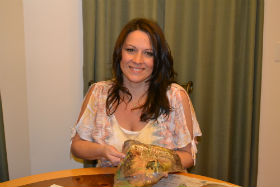 Cynthia with the remains of an album by Wadsworth Mansion, a group that recorded for Sussex Records in the 1970's
Cynthia with the remains of an album by Wadsworth Mansion, a group that recorded for Sussex Records in the 1970's
We had set up an interview on Saturday evening in early December after her last hair appointment. She had begun to feel ill late in the afternoon and called me to cancel, but I had inadvertently turned off my cell phone and did not get her message. Luckily, she was feeling better by the time we arrived and we able to examine her discoveries and conduct an interesting and very eerie interview.
It quickly became clear during our interview that Cynthia felt that there was something else in play regarding her sudden interest in ARP and the records she dug up. “In my mind, SOMETHING drew me out of bed the night I discovered your website, and 1 hour before the 41st anniversary of the fire no less. Then 2 days later to have 2 clients cancel in a row (which gave me just enough time) and SOMETHING drew me to go dig in the field, and SOMETHING showed me where to go dig. SOMETHING wants me to be a part of all this! I’m not sure why or what, but I AM certain of it!”
There might be a possible explanation for the "SOMETHING" from what she revealed next. Cynthia said that over the years, they have had several weird or unusual experiences that she described as “ghost things”. When her daughter, Hunter, was three and a half years-old, she would come out to the railing of the stairs and ask “What?”, but her parents hadn’t called her. It happened so often that Cynthia sat down and talked to her daughter about it. Hunter said that “sometimes when you call me I look up and it’s you and dad, but you don’t have any hair and you’re wearing white clothes”.
Hunter also revealed that there was a little boy that played with her in her room a couple of times, but never spoke to her. Cynthia and her husband were never into ghosts or the supernatural, and nothing like this had ever been discussed in their home prior to the above events which lasted 3 or 4 months. The occurrences then suddenly stopped, and Hunter never mentioned having any other similar visions or visits again. 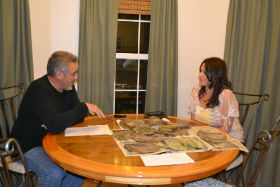 Discussing "ghost things" with Cynthia during an interview in her home in early December, 2013
Discussing "ghost things" with Cynthia during an interview in her home in early December, 2013
Another unusual event involved the one of the three recessed ceiling lights in Cynthia’s salon. She said the light at the far end of the salon will “start swaying” and then stop. She and Matt checked the light with everything in the house but there were no vents or air conditioning ducts that would account for the movement. “No one was running a washer, dryer, or any other type of appliance. It seems to start and stop on its own”, Cynthia said. The fact that it’s a recessed light made it even more difficult to comprehend.
Cynthia also mentioned that sometimes when she is lying in bed at night, she gets a very strong cigarette smell, almost like someone is blowing cigarette smoke in her face. Cynthia has a very strong allergy to tobacco smoke, so no one smokes in their home. Over the years, she and Matt have joked that maybe it was her other grandmother who was a smoker. These events got her to wonder if anyone had died in the ARP fire, but she had never taken the time to sit down and look it up as she was running her business and caring for her family.
I was fascinated by the things that Cynthia had told me, and the following day I called Dick Coughlin to see if he could give me any insight into the events she had described. After I shared some of the unusual phenomena that Cynthia and her family had experienced, Coughlin told me that it sounded like an example of a residual haunting and expressed an interest in having his team investigate Cynthia’s home free of charge. I told him that I would pass on his contact information to her in case she would care to follow up on his offer.
Residual hauntings are somewhat difficult to describe but, according to ghost hunters, are fairly common in the world of the paranormal. Also known as psychic impressions, residual hauntings are playbacks of past events. The apparitions involved are not spirits, they are “recordings” of the event. Researchers in this field believe that in much the same way that video and audio tapes capture sounds and images on materials that have been oxidized, electrical mental impressions released during traumatic events can somehow be “stored” in moist rocks and materials found in nature and used in building construction. These materials may record the event for future “playback”. 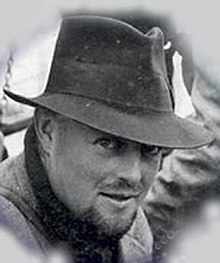 Parapsychologist Thomas Charles Lethbridge
Parapsychologist Thomas Charles Lethbridge
Paranormal investigators believe that everything is made up of energy and energy cannot be destroyed. Therefore when an emotionally-charged event occurs, the energy imprints upon our world. It is the release of this residual energy that creates the ghost person or ghostly scene, and certain materials may record the event and play it back in the future. The idea was first proposed by British archaeologist turned parapsychologist Thomas Charles Lethbridge in 1961. Lethbridge believed that ghosts were not spirits of the deceased, but were simply non-interactive recordings similar to a movie. According to this theory, residual hauntings are not dangerous since there are no spirits involved. They are past events playing in the present but with no interaction or connection to the present.
If the unusual occurrences described by Cynthia were examples of a residual haunting, the intriguing question is what was the traumatic, emotionally-charged event that caused it? It would seem that the most obvious possibility would be the catastrophic fire that destroyed the American Record Pressing plant in 1972. Although there were no reported fatalities, the blaze was battled for hours by firemen from Owosso, Corunna, Owosso Township, and Caledonia Township. The fire departments were hampered by the fact that the fire had already had a good start by the time they arrived and by the fact that there was only one hydrant near the building. The 60,000 square-foot factory was a total loss. 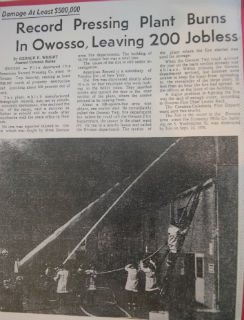 Owosso Argus-Press story
Owosso Argus-Press story
American Record Pressing was an important employer in Owosso and the loss of the company was especially devastating to the people who worked there. Dale Reid was employed by ARP at the time of the fire. In an interview conducted in 2003, he expressed the impact the fire had on the community. “It put a lot of people out of work, including me and my oldest son. The plant employed several hundred workers as they had three shifts at the time. I was 49 years-old and had to start all over again. I lost my three-week vacation pay and a pension that was in the process. It was an extremely difficult time.”
David Howell, vice president of manufacturing and production, told the Owosso Argus-Press on the day after the fire that “the company will definitely rebuild”; but it never happened. Despite Howell’s optimistic comments to the press, ARP was not doing that well in 1972. The company had been hurt by Motown’s move from Detroit to Los Angeles in 1971. Motown had represented about 80% of ARP’s business in the 1960s, and their relocation to California had been a major blow to ARP’s bottom line.
According to Jeff Mellentine, the night shift supervisor at the plant, future prospects for the company, especially with Motown gone, did not look promising and made the rebuilding of the plant highly unlikely. By 1972 the record album had surpassed the single in importance. ARP was pressing more albums than ever before but this was not an area of the company’s expertise; and the fact that ARP was not producing a quality vinyl album was also hurting their profits. In addition, the company had experienced some serious labor unrest after the United Auto Workers had unionized the plant. A nasty strike had turned violent and resulted in several arrests. The family atmosphere that had been prevalent at ARP in the 1950’s and 1960’s had pretty much disappeared by the time of the fire.
Viewlex, the New York company that had purchased ARP from Norman Dufour in 1969, was having financial problems of their own and most likely had no intention of ever rebuilding in Owosso. Viewlex then became involved in a long battle with US Fidelity & Guaranty over the insurance settlement for the fire that lasted until 1979. During that seven-year period, the burned husk of ARP remained untouched except for souvenir collectors and area children picking through the rubble of the once proud company.
Mellentine purchased the 30-acre ARP property in the 1980's with the help of the company's first owner, Norman Dufour. Mellentine entertained thoughts of building a new record pressing plant on the site but his plans never came into fruition. He demolished the remnants of the burned-out ARP building and bulldozed it and its contents into several large holes that were dug into the land. There they remained for nearly three decades until Cynthia was inspired to start digging in 2013.
The property, which Mellentine had been using as hunting land, was sold to the City of Owosso in the 1990's. Owosso then sold it to a land developer who built several homes along W. King Street, including the house purchased by Cynthia and Matt. The remaining 17-acre parcel behind the homes has changed hands several times since then.
It is interesting to note that Owosso has had quite a fire history over the years. Including the ARP blaze, there have been more than four dozen major fires in the Owosso area – a pretty significant number for a small community. The word arson often comes up when the subject turns to the city's fires. According to Jeff Mellentine, who grew up across the street from ARP, there were also two previous fires at the building when it housed Owosso Mobile Homes from 1955 to 1962.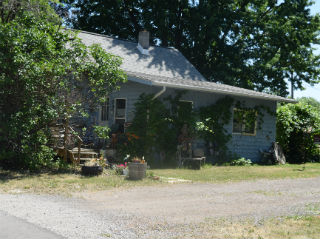 The Mellentine house on the corner of Cleveland and W. King. Mrs. Mellentine saw the mysterious large black car from these windows
The Mellentine house on the corner of Cleveland and W. King. Mrs. Mellentine saw the mysterious large black car from these windows
Mellentine claimed that there were a lot of rumors and accusations in Owosso following the fire. Arson was a popular theory and one involved the fire being set as revenge for ARP selling illegal copies of Motown recordings. These would be discs that were secretly pressed from the original masters and then sold without giving any of the money to Motown or its artists. Mellentine also revealed that his mother had awakened in the early morning hours of October 30th and had seen a large black car driving around the building. Thinking it unimportant, she did not mention the fact to her son until a later date and was never interviewed by the team of arson investigators. B
Besides Cynthia, I had one more Owosso resident looking into ARP’s history. I met Mary Hinds while doing a story on Noel (Paul) Stookey who, along with Peter Yarrow and Mary Travers, went on to fame and fortune as part of the folk music trio Peter, Paul & Mary. Stookey and Mary Hinds had a campus romance during their freshmen year at Michigan State University, and Stookey Was A Spartan was an interesting story about the star’s early years in Michigan as a student and aspiring musician.
After their relationship ended, Mary transferred from MSU and met her future husband. The young couple moved to Owosso, and Mary and her husband purchased their first home from ARP’s David Howell. I had told Mary about Cynthia’s discoveries and asked her, since she was a resident of Owosso, if she would make some inquiries about ARP.
Mary’s husband no longer drives as the result of illness but he loves to meet with friends regularly at a local Owosso restaurant. Mary drives him to the get-togethers and then retires to a booth where she reads until it’s time to drive her husband back home. She had made some inquiries about records pressed at ARP from some local collectors but had not gathered any significant information. Apparently someone had overheard her conversations because several weeks later she was approached by a man in the restaurant who told her: “I have something that will interest you.” 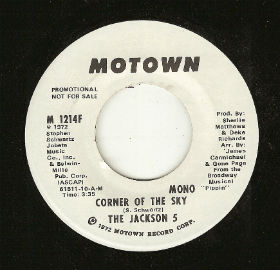 One of the records given to Mary Hinds was this promo 45 that was pressed at ARP in the fall of 1972. The Jackson 5 single debuted on the Billboard Hot 100 on October 28th - two days before the devastating fire
One of the records given to Mary Hinds was this promo 45 that was pressed at ARP in the fall of 1972. The Jackson 5 single debuted on the Billboard Hot 100 on October 28th - two days before the devastating fire
The “something” was two boxes of 45s that had been pressed at ARP shortly before the fire in 1972. All of the records had the standard white paper slipcases that ARP put on its 45s and they were in excellent condition, either never played or played just one or two times.
What was more significant, however, was the story behind the records. He told Mary that a friend of his who worked at ARP had left the two boxes of 45s on his porch sometime during the night of October 29, 1972. When he asked the friend why he had left the records, he replied: “I didn’t want to see them get destroyed in the fire.” If the man’s story is true, it means that his friend had prior knowledge of the fire and that the cause must almost surely have been arson.
Mary and I usually met in a coffee shop in downtown Bay City for our interviews since she was born in the town and still has friends there she likes to visit. At our last meeting Mary brought several of the Motown 45s to give to me. These were the records: “That’s How Love Goes” by Jermaine Jackson – 1972, “Corner Of The Sky” by The Jackson 5 – 1972 (promo copy), “(It’s the Way) Nature Planned It” by The Four Tops – 1972, “I Guess I’ll Miss The Man” by The Supremes – 1972, “Girl You’re Alright” by The Undisputed Truth – 1972, “Papa Was A Rollin’ Stone” by The Temptations – 1972, and even an obscure 1972 single by Lesley Gore on Motown's MoWest subsidiary. It seems amazing that this man had held onto these records for over 40 years, and although they do not conclusively prove anything, they add another thread to a mystery that still seems to be unfolding. 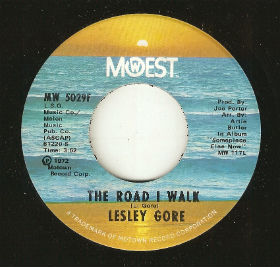 This Lesley Gore single on the MoWest label was pressed at ARP in 1972
This Lesley Gore single on the MoWest label was pressed at ARP in 1972
During one of my last phone conversations with Cynthia she told about two more recent paranormal events in her home. The first occurred in her hair salon which has two heavy wrought iron hanging candle holders that are on both sides her mirror. As she sat watching TV in between clients recently, one of the candle holders started swinging. She immediately picked up her phone and recorded it on video. She told me that it takes a good deal of effort to make one of the candle holders move – you literally have to push it. To see if something else could make it move, Cynthia opened the window to let in a breeze, and then turned a fan on it, but neither made it budge.
The other event involved her husband Matt, who had never really believed that any of the events that had happened in the house were paranormal. Matt works in the Lansing area; and when he comes home from work, he usually gets something to eat, watches some TV, brushes his teeth, and goes to bed.
On this occasion, he went upstairs to brush his teeth but when he got to the top of the steps, he saw out of the corner of his eye a white shape in front of his daughter’s bedroom door. When he turned his head to look, however, nothing was there. He then went into the bathroom and was leaning over the sink and brushing his teeth when he said to himself: “If there is anyone here, just make yourself known”. He said it in jest although he knew that he saw something. Nothing happened, so he went back downstairs and went to bed.
The next morning, Matt went back upstairs and was looking down as he came up the stairs. When he got to the top, that same white object was right in front of him. Then it quickly swished into the bathroom and around the door. Matt cautiously went in the bathroom and looked around, but saw nothing. While he was brushing his teeth, he once more said to himself: “if anyone is here, make yourself known.” Again, nothing happened. But as he went downstairs and turned to walk through the center of the living room, he literally felt something walk right through him, and it made every hair on his body stand on end. He told Cynthia what had happened and described the sensation as “the craziest feeling ever.”
Since Matt had his ghostly experience, nothing else has happened in the house. Despite all of the unusual events described above, the couple has yet to contact a paranormal investigator.
Cynthia has been surprised at the lack of interest in ARP at both the Owosso Historical Commission and the Shiawassee Arts Center which has recently produced an exhibit that shines light on Owosso’s rich and storied history in the retail and manufacturing industries. There was a small display on the American Record Pressing company that would have been enriched by including some of the album remains from the fire that Cynthia uncovered. Unfortunately, this seems to be the case all across Michigan; wherein various historical societies seem to have limited interest in pop or rock and roll culture as important parts of a region’s history, despite the music’s wide appeal. 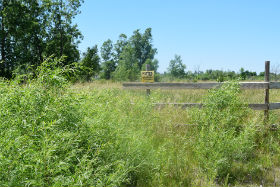 The property containing the remains of the American Record Pressing company is now fenced off and posted with No Trespassing signs
The property containing the remains of the American Record Pressing company is now fenced off and posted with No Trespassing signs
The 17-acre parcel of land behind their home containing the rest of the ruins of ARP has recently been sold; and the new out-of-town owners have fenced in the property and peppered it with 'No Trespassing' signs. That will limit any further exploration and probably destroy any relics that might be left when the land is cleared and the construction starts for their new home and horse ranch.
Cynthia planned to use her residency and contacts in the Owosso to find out more about ARP, but has currently hit a dead end. There still may be residents that remember the plant and even some who worked there who might be able to shed more light on one of Owosso’s most famous businesses, but that remains to be seen.
This MRRL's third and, most likely, final story on the American Record Pressing company. Some important unanswered questions remain, however. What was the true cause of the fire that destroyed ARP? Was arson involved? Are the strange events in the home of Cynthia and Matt examples of a residual haunting? And if it is indeed a residual haunting, did the highly emotional or traumatic events that caused the recording have anything to do with ARP or the fire that desroyed it in 1972?
Even if none of these questions will ever be answered satisfactorily, the ARP story is a fascinating one with a host of mysterious twists and turns. In writing this unusual tale, I was reminded of that famous Bob Dylan lyric from “Ballad Of A Thin Man”: Something is happening here but you don’t know what it is - Do you, Mr. Jones?

